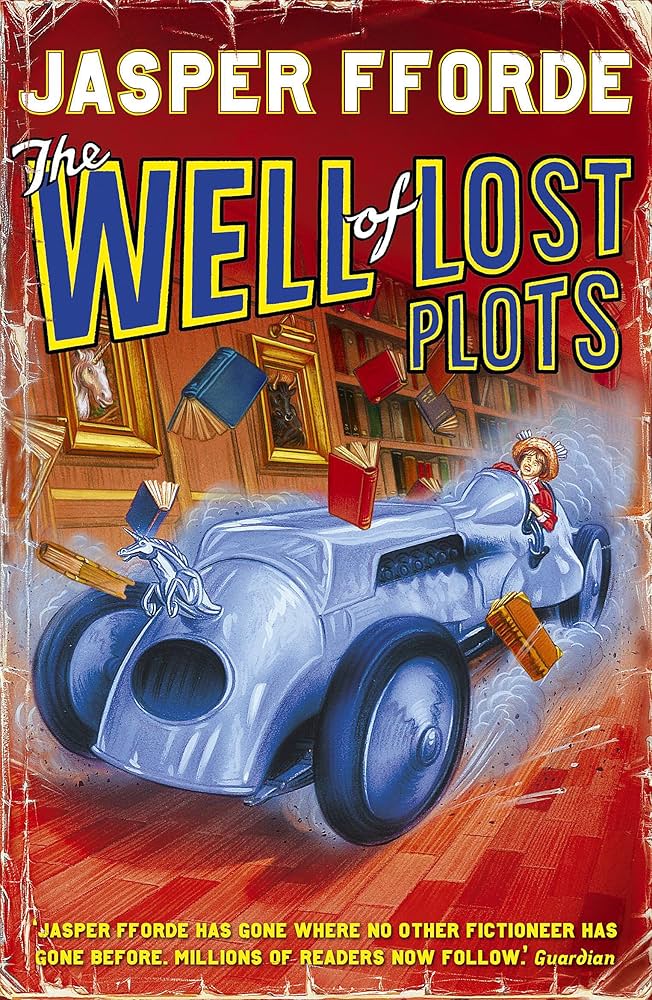In the ever-expanding universe of metafiction, few works manage to dance so deftly between inventiveness and literary homage as Jasper Fforde’s The Well of Lost Plots. This novel, a curious labyrinth of stolen narratives and enchanted manuscripts, invites readers not just to follow a story, but to wander its corridors, question its walls, and uncover the mysteries hidden within its pages. As we step into fforde’s literary maze, this review seeks to navigate the twists and turns of his inventive world, exploring both its playful creativity and structural intricacies.
Unraveling the Intricate World Building and Meta-Narrative Tricks That Define The Well of Lost Plots

Jasper Fforde’s the Well of Lost Plots deftly constructs a universe that blurs the lines between fiction and reality, inviting readers into a labyrinthine literary realm where every plot twist is meticulously engineered. the BookWorld, as portrayed, is not merely a backdrop but a living, breathing entity governed by its own laws and bureaucracies. characters traverse genres like shifting landscapes, and narrative devices become tangible tools wielded by agents tasked with preserving story integrity. This layering of worlds within worlds results in a meta-narrative puzzle where books are simultaneously the setting and the storyline – a concept that challenges conventional storytelling and rewards attentive readers with a journey through the architecture of fiction itself.
The novel employs a unique palette of meta-narrative tricks that pull back the curtain on the storytelling process. Some of the most captivating techniques include:
- Character personification of literary devices: Traits like Prologues, Epilogues, and Plot Holes are anthropomorphized, giving abstract concepts tangible form.
- Genre blending and manipulation: Characters effortlessly move between mysteries, romances, and thrillers, exposing the mechanics behind genre conventions.
- self-referential humor: The narrative frequently breaks the fourth wall,engaging readers with wry commentary on the artifice of fiction.
| Meta-Narrative Element | Function | effect |
|---|---|---|
| BookWorld Bureaucracy | regulate Storylines | Adds satirical depth to literary culture |
| Plot Editing | Correct Narrative Errors | Highlights fragility of storytelling |
| Lost Plots | Preserve Orphaned Stories | Explores theme of abandonment and renewal |
Such methods intertwine seamlessly to create a text that is both an homage and a critique of literary traditions, making the novel an intriguing meditation on creativity, authorship, and the endless possibilities nested within the written word.
A Close Look at Character development and Interactions That Bring Depth to Jasper fforde’s Narrative Labyrinth

Jasper fforde masterfully populates his narrative labyrinth with a cast of characters whose layers unfold like the intricate pages thay inhabit. Each figure is crafted with quirky depth, blending whimsy with sharp psychological insight. Protagonist Thursday Next, for example, is not merely a book detective but a vibrant conduit between reality and fiction, embodying the vrey essence of Fforde’s metafictional world. the interactions between characters are marked by witty banter and poignant moments, creating a dynamic interplay that reflects the thematic complexity of storytelling itself. These moments invite readers to not only follow a plot but to explore the emotional and intellectual tapestries woven into the narrative.
Character relationships function as vital nodes in this literary web, revealing layers of conflict, alliance, and growth. The camaraderie and tension between thursday and her colleagues in the BookWorld agency are painted with a deft hand, frequently enough oscillating between humor and sincerity. This balance breathes life into the labyrinthine setting, transforming it from mere backdrop to a living entity. Below, a snapshot of key interactions illustrates how Fforde’s characters drive the story forward:
| Character Pairing | Nature of Interaction | Importance |
|---|---|---|
| Thursday Next & Aornis Hades | Antagonistic rivalry | Explores themes of control and chaos |
| Thursday Next & Miss Havisham | Mentorship & empathy | Connects literary worlds with emotional depth |
| Thursday Next & mycroft Next | Sibling rapport | Grounds narrative in familial reality |
How Humor and Wit Serve as Key Tools in Navigating the Complex Plot Structure of The Well of Lost Plots

Jasper Fforde masterfully employs humor and wit as essential navigational beacons through the labyrinthine narrative of The Well of Lost Plots. The story’s intricate layering of genres, characters, and metafictional twists could easily become bewildering, yet Fforde’s sharp, playful dialogue and clever comedic timing transform complexity into accessibility. His witty banter not only entertains but also serves as a subtle guide,unraveling tangled plot threads with just the right amount of levity. This clever use of humor lightens the cognitive load on readers, allowing them to engage with the novel’s multifaceted structure without feeling overwhelmed.
Moreover, humor in the novel operates on multiple levels, bridging characters from disparate literary worlds and creating unexpected connections that underscore the absurdity of a universe governed by storytelling conventions. The author’s knack for satirical commentary emerges through humorous exchanges that double as critical reflections on literature itself. Below is a speedy glimpse at the types of humor that enrich this narrative and help steer readers through its complex architecture:
- Metafictional jokes - Self-aware quips about storytelling rules and tropes.
- Character-driven wit – Humorous personalities who defy clichés and stereotype expectations.
- Situational comedy - Absurd scenarios emerging from the collision of literary genres.
- Wordplay and puns – Linguistic cleverness that rewards attentive readers.
Exploration of Genre Blending and literary References That Enrich the Reading Experience and Challenge Traditions
Jasper Fforde’s narrative alchemy in The Well of Lost Plots defies classification, weaving layers of literary genres into an intricate tapestry that feels both familiar and astonishingly fresh. The novel smartly oscillates between mystery, fantasy, and metafiction, conjuring a world where the boundaries between author and character, reader and story, blur seamlessly. This genre blending doesn’t just serve as a stylistic flourish; it challenges conventional storytelling by forcing readers to question what defines a narrative and how meaning is constructed. Through this playful hybridity, Fforde invites us to revel in a literary playground where the rules of engagement are rewritten with wit and intellectual rigor.
Intertextuality reigns supreme, with countless literary references enriching the reading experience and rewarding the attentive. Characters named after iconic authors, subtle nods to classic detective fiction, and witty meta-commentary on narrative tropes transform the text into a living conversation with literary history. The inclusion of these layers creates a dynamic interplay between the reader’s prior knowledge and the unfolding plot.
- Detective Genre Tropes twisted with metafictional humor
- Character archetypes borrowed and subverted from classical literature
- References to canonical works embedded as narrative clues
| Genre Influence | Example in the Novel | Effect on Reader |
|---|---|---|
| Fantasy | Manipulation of fictional worlds | Creates imaginative freedom |
| Mystery | Plot involving the search for lost narratives | Engages curiosity and intrigue |
| Metafiction | Characters aware of their own fictional status | Challenges reader’s perception of reality |
Themes of Creativity,Censorship,and Authorial Control Explored Through Fforde’s Inventive Storytelling Approach
Jasper Fforde’s narrative canvas in The Well of Lost Plots brims with a delightful interplay between creativity,censorship,and the elusive grasp of authorial control. Through his inventive world where literary characters and plots live and breathe, Fforde challenges traditional boundaries of storytelling. The novel serves as a metafictional playground, reflecting on how stories evolve and resist stylistic confinement.The creative process itself becomes a character, subject to whims and revisions, while the shadow of censorship looms-both overt and subtle-questioning who truly holds the pen. Fforde’s playful yet pointed prose invites readers to consider that creativity is a dynamic tension between freedom and constraint, where each plot twist is a dance with disciplinary forces.
The tension between control and chaos is further illuminated through a spectrum of interesting concepts:
- Plot Management: Characters themselves grapple with narrative destinies, highlighting how restrictive frameworks shape creativity.
- Censorship as World-Building: Restrictions often define worlds as much as they limit them, curating the literary ecosystem Fforde crafts.
- Authorial Authority vs. Reader Interpretation: The story blurs lines as authorial commands are questioned by characters gaining self-awareness.
| Element | Role in the Story | Implication for Creativity |
|---|---|---|
| BookWorld | Living library where characters reside | Creates a meta-space for exploration of story mechanics |
| Editorial Police | Enforces censorship and narrative conformity | Embodies external pressure limiting creative liberties |
| Protagonist Thursday Next | Agent navigating control and rebellion | Represents the struggle for authorial freedom |
By merging imaginative storytelling with incisive commentary on narrative authority, Fforde crafts a unique literary labyrinth-one where the freedom to create is both celebrated and scrutinized, ensuring readers emerge not only entertained but also contemplative about the forces shaping every story they encounter.
The Role of Narrative Innovation and Genre Deconstruction in Making The Well of Lost Plots a Unique Literary Journey
Jasper Fforde invites readers into a labyrinthine world where narrative conventions are both celebrated and subverted, crafting an experience that is as intellectually stimulating as it is entertaining. Through innovative storytelling, The Well of Lost Plots blurs the boundaries between reality and fiction, inviting readers to become detectives within the very pages they turn. This narrative innovation reshapes traditional plot progression, employing metafictional elements that breathe life into characters and manuscripts alike. The novel’s courage to experiment with form not only challenges readers’ expectations but also rekindles a sense of wonder toward the mechanics of storytelling itself.
Central to this literary journey is Fforde’s deft genre deconstruction, where familiar tropes are playfully dismantled and reassembled. By traversing multiple genres-from detective noir and fantasy to science fiction and romance-the novel creates a patchwork that defies easy categorization.Some of the most compelling features include:
- Self-aware characters: Entities who understand their fictional existence and question their roles within their narrative confines.
- Genre cross-pollination: Scenes that weave thematic and stylistic elements across genres, enriching the story’s texture.
- Playful subversion: Classic literary archetypes are twisted, turning clichés into fresh, unpredictable plot devices.
| Aspect | Impact on Reader | Example in Novel |
|---|---|---|
| Metafiction | Engages readers as co-creators | Characters discussing their plot roles |
| Genre Fusion | Evokes surprise and delight | Blending mystery with fantasy elements |
| Self-Referential Humor | Lightens complex narrative themes | Comic nods to publishing industry quirks |
Detailed Analysis of Pacing and Suspense Techniques That Keep Readers Engaged from Start to Finish
Jasper Fforde masterfully manipulates the rhythm of his narrative, weaving moments of breathless action with contemplative lulls that invite readers to pause and reflect. The pacing is carefully calibrated, never allowing the story to stagnate, yet avoiding a relentless rush that might overwhelm. Fforde employs a blend of sharp, witty dialogue and intricate plot developments, creating layers of intrigue that steadily build suspense. This dynamic flow is amplified by his strategic placement of cliffhangers, which appear just as you settle into a scene, compelling you to turn the page and unravel the next twist in the labyrinthine plot.
Several key techniques keep the engagement high throughout the novel:
- Shifting narrative perspectives that reveal pieces of the puzzle slowly
- Unexpected genre-bending that defies reader expectations
- Subtle foreshadowing that teases forthcoming revelations
- Complex character motivations intertwined with the metafictional setting
- Balanced bursts of humor that alleviate tension without disrupting mood
| Technique | Effect on Suspense |
|---|---|
| Cliffhangers | Maintain high tension between chapters |
| Foreshadowing | Creates anticipation and reader curiosity |
| Multiple Viewpoints | Expands narrative depth and suspense through varied insights |
| Genre-Mixing | Disorients expectations, keeping readers on their toes |
Insights into the Use of Language Play and Wordsmithing That Highlight fforde’s Signature style Throughout the Book
Jasper Fforde’s knack for linguistic inventiveness is woven intricately throughout the Well of Lost Plots, transforming the narrative into a playground where language itself is the main character. His clever manipulation of syntax and semantics invites readers into a world where puns don’t just amuse-they serve as critical narrative devices. Through deft wordsmithing, Fforde conjures an atmosphere that oscillates effortlessly between whimsy and intellectual rigor, making the text not only entertaining but also richly rewarding for lovers of literary puzzles.
Several hallmark techniques come alive in Fforde’s prose, including:
- Metafictional wordplay: Characters discuss plot devices as if they were tangible elements, blurring the boundary between fiction and commentary.
- inventive neologisms: New words and expressions surface seamlessly, breathing life into the fictional landscape.
- Genre-bending terminology: Descriptions and labels challenge traditional literary categories, reflecting the book’s labyrinthine nature.
The interplay of these techniques can be succinctly represented as follows:
| Technique | Effect |
|---|---|
| Metafictional Wordplay | Invites readers into a self-aware literary universe |
| Inventive Neologisms | Expands the novel’s imaginative scope |
| Genre-Bending Terminology | challenges reader expectations and classifications |
Why The Well of Lost Plots Appeals to Both fantasy Enthusiasts and Literary Aficionados Alike
The magic of The Well of Lost Plots lies in its seamless fusion of two seemingly distinct literary worlds. Fantasy enthusiasts are drawn to its imaginative setting-a labyrinthine repository where forgotten narratives drift in limbo, awaiting rediscovery. This vivid backdrop invites readers into a universe brimming with magical realism, inhabited by quirky characters who traverse between reality and fiction. The intricate world-building satisfies those craving escapism, complete with enchanted realms, mysterious artifacts, and the thrill of literary adventure.
Yet, the novel equally captivates literary aficionados with its metafictional cleverness and incisive commentary on storytelling itself. Fforde crafts a narrative rich with playful allusions to classic literature and cleverly subverts traditional plot conventions. Within the Well, the rules of writing become as tangible as physical laws, exposing the anatomy of narrative techniques and character archetypes. A look at the table below highlights some key elements that illustrate this dual appeal:
| Element | Fantasy Appeal | Literary Appeal |
|---|---|---|
| Setting | A magical archive with endless corridors | A metafictional space symbolizing the creative process |
| Characters | Heroes, villains, and literary agents come to life | Personifications of plot devices and tropes |
| Themes | Adventure, mystery, and magic | Narrative theory, creativity, and literary critique |
Practical Recommendations for Readers New to Jasper Fforde on How to Approach and Appreciate This Complex Work
Stepping into Jasper Fforde’s imaginative realm can initially feel like navigating a maze constructed from words and literary allusions. To truly savor the intricate layers of The Well of Lost Plots, readers are encouraged to embrace the novel’s playful tone and resist the urge to rush through the story. Patience is key; allow yourself to linger on quirky details and relish the witty dialogue that underpins much of the narrative’s charm. It’s also helpful to approach the book with an open mind regarding genre boundaries, as Fforde masterfully blends mystery, fantasy, and metafiction into a seamless tapestry that rewards attentive exploration.
- Engage with the book world: Familiarity with classic literature enhances the experience, but isn’t mandatory.
- Take notes or bookmarks: Characters and plot mechanics can be intricate, so tracking them can deepen appreciation.
- Discuss and share: Joining reading groups or online forums can illuminate subtle nuances and unexpected connections.
| Tips | Purpose |
|---|---|
| Have a glossary ready | Decode literary jargon and references effortlessly |
| Pause to reflect | Absorb plot twists and thematic depth |
| Revisit favorite passages | Uncover layered meanings and humor |
Suggestions for Book Clubs and Discussion Groups on Topics and Questions Inspired by The Well of Lost Plots
Book clubs diving into The Well of Lost Plots can enrich their sessions by delving into the concept of metafiction and its impact on narrative structure. Challenge members to explore how Jasper Fforde blurs the boundary between reality and fiction,and to debate weather the characters’ agency within the BookWorld mirrors our own interpretations of fate and free will. Additionally, groups might consider the thematic significance of literary genres interacting in a single universe – how does Fforde’s playful mash-up of mystery, fantasy, and satire reshape our expectations of storytelling? Encourage discussions that draw parallels between the BookWorld’s bureaucratic intricacies and our real-world institutions, questioning what this reveals about control, creativity, and authorial intent.
For a more interactive approach, discussion leaders can propose thought-provoking questions and activities such as:
- Character Alignment Exercise: assign participants favorite BookWorld characters and debate their motivations, strengths, and narrative roles.
- plot Puzzle Workshop: Create alternative scenarios by rearranging key plot points – how would the story evolve if characters made different choices?
- Genre Cross-Pollination Debate: Examine how mixing genres affects reader expectations and the author’s creative freedom.
| Discussion Theme | Suggested Questions |
|---|---|
| Metafiction & Reality | How does fforde use metafiction to deepen the narrative? what blurred lines stand out? |
| Authority vs. Creativity | In what ways does the BookWorld’s bureaucracy limit or inspire creativity? |
| character Empowerment | Do characters possess true free will, or are they bound by the author’s design? |
Visualizing the Labyrinthine Setting of the Book for an Immersive Reading and AI-Generated Imagery Experience
The intricate corridors and hidden chambers of Jasper Fforde’s labyrinthine book-world come alive when visualized through detailed maps and AI-generated imagery, transforming abstract literary spaces into immersive landscapes. By leveraging AI art tools, readers can journey through the BookWorld with vivid portrayals of Classified Manuscripts and the shadowy Underground Library, enriching their understanding of the novel’s complex setting. These visual aids illuminate the tangled pathways, from the shifting Narrative Labyrinths to the Archive Halls, offering a fresh outlook that transcends traditional reading and invites deeper engagement with the text’s multifaceted surroundings.
- Enhanced spatial awareness: Visual representations clarify the relationships between characters, plotlines, and story arcs intertwined within the labyrinth.
- AI-generated creativity: Refined algorithms reinterpret Fforde’s descriptions to produce art that balances fidelity with imaginative flair.
- Interactive exploration: Readers can navigate through graphic maps and scene reconstructions, simulating expeditions through the book’s meta-fictional world.
| Location | Function | imagery Notes |
|---|---|---|
| narrative Labyrinths | Plot control & trials | Twisting pathways,shifting walls |
| Classified Manuscripts Vault | Secure storage | Dimly-lit,filled with glowing scripts |
| Underground Library | Research & refuge | Mystical,endless rows of books |
Reflecting on the Impact of The Well of Lost Plots Within Contemporary Fantasy and Literary Fiction Genres
Jasper Fforde’s narrative playground has redefined the boundaries of what contemporary fantasy can achieve within literary fiction. By constructing a meta-literary universe where stories are living entities and characters navigate their own plots, The Well of Lost Plots challenges traditional storytelling mechanics. This boundary-blurring approach encourages readers and writers alike to reconsider the nature of narrative authorship, agency, and the lifecycle of fictional worlds. It fosters a unique dialogue between genres-melding whimsy and intellectual rigor-that inspires modern authors to experiment boldly, cultivating a new wave where fantasy is not just escapism but an intricate examination of the art of fiction itself.
Its impact is evident through several nuanced shifts in the genres’ landscapes, including:
- Emphasis on metafictional devices that invite readers to engage with storytelling on multiple levels.
- Increased popularity of genre-bending works that fuse fantasy elements with literary depth.
- Heightened awareness of narrative structures and the “life” of characters beyond their original stories.
| Aspect | influence in Contemporary Fantasy | Influence in Literary Fiction |
|---|---|---|
| Storytelling Approach | Embracing playful world-building | Experimenting with narrative form |
| Character Agency | Characters acting beyond archetypes | Exploration of existential themes |
| reader Engagement | Interactive, immersive reading experience | Reflection on the role of the reader |
The Visionary Author Jasper Fforde Whose Imaginative Storytelling Continues to Captivate and Inspire Readers Worldwide
Jasper Fforde’s ability to weave a narrative that dances effortlessly between reality and fiction is nothing short of extraordinary. In The Well of Lost Plots, readers are invited into a labyrinthine world where every page of unwritten stories forms a fragile ecosystem, reflecting Fforde’s deep reverence for literature itself. His clever manipulation of literary conventions and genres turns the novel into a meta-adventure, where plot twists are not just surprises but celebrations of storytelling creativity. The protagonist’s journey through the Library’s hidden layers showcases Fforde’s signature wit, layering humor with insightful commentary on the art and mechanics of writing.
The book’s charm is further amplified by its vivid cast of characters and inventive concepts, including:
- Bookworld agents tasked with preserving narrative order
- Sentient stories that evolve based on reader interaction
- Genre zones where familiar literary themes collide and morph
These imaginative elements make The Well of Lost Plots a rich tapestry that invites readers to question the boundaries of fiction and reality. it’s a playful reflection on the endless possibilities contained within the written word, a tribute to those who live between the lines and beyond the margins.
| Characteristic | Description |
|---|---|
| Narrative Style | Playful and self-aware, blending genres |
| Protagonist | thursday Next, literary detective extraordinaire |
| Themes | Metafiction, the power of narrative, literary homage |
| Appeal | Readers who cherish clever wordplay and inventive storytelling |
In winding through the intricate corridors of Jasper Fforde’s The well of Lost Plots, readers find themselves both participants and spectators in a literary game where stories breathe and characters dance beyond their pages. This novel invites us to ponder the very nature of storytelling, blurring lines between reality and fiction with playful ingenuity. While its complexity may challenge some, those willing to delve deeper will uncover a rich tapestry of imagination and wit. Ultimately, The well of Lost Plots is a curious labyrinth-an adventurous read for those who delight in the art of narrative itself.









